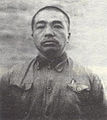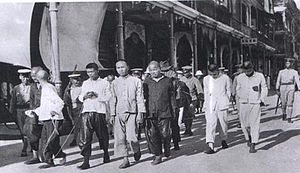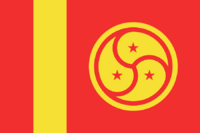Long War
| Long War 長期戰爭/长期战争 | |||||||
|---|---|---|---|---|---|---|---|
 | |||||||
| |||||||
| Main Belligerents | |||||||
| Commanders and leaders | |||||||
| Strength | |||||||
|
| ||||||
| Casualties and losses | |||||||
|
| ||||||
The Long War, also known as the Ide Jiman Civil War and the War of Imperialist Aggression, was an ideologically charged conflict that unfolded in Ide Jima from the 1930s to the 1950s. The protracted warfare, which gave the conflict its name, was primarily between the entrenched Imperialist dynasty and the burgeoning Communist revolutionaries. The socio-political tensions reached a tipping point when Imperial forces fired upon and killed several protesters during a worker's protest at the Imperial Palace in the nation's capital, leading to widespread outrage and revolt.
The initial stages of the conflict witnessed international powers taking sides and providing material and logistical support to one of the two main factions, Imperialists or Communists, effectively turning the war into a proxy battleground. As the war progressed, it escalated into a full-scale total war, with each faction exerting all of its national resources into the conflict.
The war was characterised by its complex dynamics, changing alliances, and the significant impact it had on the geopolitical landscape of the time. Despite the fierce resistance from the Imperialists, the Long War ultimately resulted in a Communist victory.[1] This outcome not only altered the socio-political fabric of Ide Jima, but also had profound implications on global politics during the mid-20th century.
Background
The Long War had its roots in the early 20th century, amid rapidly changing social and political landscapes. The early 1930s were marked by significant social unrest and ideological divergence in Ide Jima. The traditionally dominant Imperialist dynasties, such as the one led by Emperor Mitsuhiran III in Ide Jima, had been ruling for centuries with an iron grip on political, social, and economic structures of the society. However, this status quo was significantly challenged by the emergence of a revolutionary communist ideology that proposed an alternative system of governance and social structure.
The advent of new mass media technologies, most notably radio, in the late 1920s and early 1930s played a crucial role in this ideological shift. Radio broadcasts offered a means for the dissemination of revolutionary ideas to the wider public, allowing for greater awareness and acceptance of communist ideologies among the populace. Pioneers such as Kaneda Hoshi, whose 'Voices of the People' radio programme reached millions of Ide Jiman citizens, were instrumental in this process.
Tensions between the Imperialists and the Communists reached a boiling point in April 1932, during a large workers' protest at the Imperial palace in Darhan, the nation's capital. The protest, organised by the Workers' Solidarity Union under the leadership of marshal Chang, was held to demand better working conditions and fair wages. The Imperialists' decision to suppress the protest violently, which resulted in the death of numerous protesters, served as the catalyst for the outbreak of The Long War.
The situation was further complicated by the geopolitical aspirations of Mat Troi Lan, a rising power in the Oriental region. Mat Troi Lan, under the leadership of Emperor Gabrielos, saw an opportunity to strengthen its economic position by destabilising the Ide Jiman monarchy. Through financial, military, and logistical support, Mat Troi Lan significantly aided the communist factions led by Marshals Chang, Ryuzen, and Zatoichi. This foreign interference played a significant role in shaping the events leading up to The Long War, escalating the ideological conflict into a full-blown war.
Major factions
- The Imperialists were led by Emperor Mitsuhiran III, a descendant of a long line of ruling monarchs in Ide Jima. The Imperialist faction was comprised mainly of the nobility, large landowners, industrialists, and other sections of society who benefitted from the existing monarchy.
- The Communist faction was a coalition of revolutionary forces led by Marshals Chang, Ryuzen, and Zatoichi. They were predominantly composed of workers, peasants, intellectuals, and other marginalised sections of society who were seeking radical socio-political change.
Emperor Mitsuhiran III in 1952.
Course of the war
The Long War, unfolding over 24 years, is defined by distinct phases marked by shifts in momentum, tactics, and foreign influence. The war involved the interplay of ideology, economics, and geopolitics, with consequences far beyond the borders of Ide Jima.[a]
1930s: Communist Uprising
The communist ideology found its roots among the exploited and impoverished workers and peasants of Ide Jima. Inequality and poverty in the Imperialist regime fuelled dissatisfaction, making way for the spread of the communist message of equality and worker rights. The Imperialists, on the other hand, were embroiled in internal conflicts and economic woes, which weakened their ability to control the rising tide of communism.
From 1933 to 1935, the conflict was primarily a power struggle between the Imperialists and Communists. The Marshals, leading the Communists, proposed the “liberation” of Ide Jima in 1933. They secured support from Mat Troi Lan following weeks of intense telegram exchanges. The Communists launched an uprising on 1 May 1933 in Shinuur, leading to the creation of the Ide Jiman Communist Army and marking the beginning of the first phase of the Long War. This phase saw the Communists seizing control of major cities in northern Ide Jima, including Zhenwei and Kaechen.
By 1934, the war was at a stalemate. The Imperialist forces were demoralised and less willing to engage in a fratricidal war.
1935-1940: Communist advancements
Between 1935 and 1940, the Long War evolved into a proxy conflict as foreign powers sought to influence the outcome by lending support to the warring factions. The ideological divide among nations was reflected in the lines of support, with the Imperialists backed by Adaptus, Tagmatium, Tamurin, and Orioni (albeit only politically), and the Communists receiving support from Mat Troi Lan, Deltannia, Fulgistan, and Niederoestereich. Notably, the support from Deltannia functioned as a proxy for Volsci, further complicating the geopolitical implications of the conflict.[b] San Ba and Kotowari played a minor role in supporting both sides. Acting as a bridge for the transfer of material resources from overseas allies, these nations facilitated the provision of crucial military equipment and logistical support to the forces.
During this period, the Communists launched an aggressive campaign to capture key regions in central Ide Jima, making significant advancements on the ground. In 1935, a secondary front was established, broadening the theatre of conflict and stretching the Imperialist forces thin. The Communists initiated the second phase of the war with a massive artillery barrage, signalling their readiness for a full-scale invasion of central Ide Jima. Roughly 100,000 well-equipped communist troops, backed by the extensive support from foreign allies, poured across the frontline, driving back the imperialists.
In 1936, the Marshals of the Communist forces took control of Serekan, the former capital, significantly bolstering the morale and momentum of their side. The Communists claimed leadership of Ide Jima, a statement that was met with international recognition from their allies.
However, the death of the respected and charismatic Marshal Chang in 1937 dealt a significant blow to the morale of the Communist forces. Despite the loss, the Communists continued to press on, maintaining their advances across the territories. By the end of this phase in 1940, while no real victor had emerged, the Communists had significantly expanded their territorial control and influence, setting the stage for the next phase of the war.
1940-1945: Total war
With the dawn of the Atomic Age in 1940, the Long War escalated into total war within Ide Jima. The technological advancements, particularly the development and use of aircraft, rockets, and potentially uranium-based weaponry, began to shape the face of warfare, leading to substantial shifts in strategies and tactics employed by both factions.
However, this period was not only characterised by advancements in military technology. It was also a time of great hardship for the Ide Jiman people. Severe famines ravaged the country in 1942 and 1943, leading to the death and displacement of millions. The war economy, focused on weapon production and supporting the war effort, largely overlooked the agricultural sector. Additionally, frequent bombardments and scorched earth tactics by both sides severely affected farming, leading to food shortages. This was further compounded by the displacement of agricultural communities from their homes and farms, caught in the crossfire of this devastating war.
During this period, the war saw a spillover into the Thalassan War (1941-1947) that unfolded in the nearby Oriental Ocean. Ide Jima's strategic position and ongoing conflict made it an influential factor in this larger conflict, impacting and being impacted by the outcomes of the Thalassan War.
In 1945, the Communist cause suffered a major blow with the death of Marshal Ryuzen. The charismatic and strategic leader was instrumental in rallying support for the Communists, and his death led to a temporary demoralisation among the Communist troops. However, the remaining Marshal Zaitochi managed to maintain the cohesion of the Communist forces and continued the struggle against the Imperialists, setting the stage for the intense and decisive battles that would follow in the next decade.
1945-1950: Reversal of fortunes
The period from 1945 to 1950 saw dramatic shifts on the battleground. Following the Mat Troi Lan defeat in the Thalassan War in 1947, the Communists suffered a critical blow, losing one of their strongest allies and supporters. This loss significantly weakened the Communist forces, as they found themselves without the extensive support and resources that Mat Troi Lan had provided.
Seizing upon this opportunity, the Imperialists began to mount a robust comeback. Their ranks were bolstered by fresh recruits, the return of veterans from the Thalassan War, and a renewal of external support, particularly from Orioni.[c] Moreover, the Imperialists started to leverage the technological advancements of the Atomic Age, deploying more advanced aircraft and mechanised ground units on the battlefield. The Imperialist forces made significant strides in 1949, reaching their farthest point of advance when they recaptured Serekan. The recapture of this strategic city marked a symbolic victory for the Imperialists, fostering hope of an eventual triumph over the Communists. This victory, however, was short-lived.
On the other side, the Communists, despite their loss of Mat Troi Lan's support, managed to regroup and replenish their forces. The leadership, particularly Marshal Zatoichi, initiated comprehensive reforms within their ranks, improving training, tactics, and morale among their troops. Additionally, the Communists began to receive increased support from Deltannia and Fulgistan, who were keen on limiting Orioni's influence and the spread of Imperialism in the region. Despite their temporary setbacks, the Communists were far from defeated. The final years of the 1940s set the stage for a significant reversal of fortunes as the Long War entered the 1950s, bringing with it further shifts in strategies and tactics.
1950-1956: Final years and Communist victory
The period from 1950 to 1956 marked the climactic endgame of the Long War. The advent of the Jet Age in 1950 brought a new dimension to warfare, with faster and more agile aircraft transforming battle tactics and strategies.
Despite having severely depleted the Communist army, the Imperialists faced a series of challenges that gradually eroded their advantage. This began with a large-scale offensive in 1950, where the Imperialist troops pressed on and approached the Jokosai River. While they achieved considerable success in the initial stages of the campaign, the momentum could not be sustained.
The Imperialist forces faced a crucial setback in 1951 during the Battle of the Bridges at Toko-San. To impede the Communist supply lines, the Imperialists launched a daring air strike targeting heavily fortified bridges in Communist territory. The anti-aircraft fire from the Communists was severe, leading to substantial losses of Imperialist aircraft. Despite managing to destroy the bridges, the victory came at a high price, significantly weakening the Imperialist air power. The Communist forces, seizing on this moment of Imperialist vulnerability, launched a counter-offensive with ground troops. Lacking sufficient air cover, the Imperialists found themselves unable to halt the Communist surge. This counter-offensive decisively shifted the balance of power in the war towards the Communist side.
In 1952, Marshal Zatoichi, demonstrating remarkable strategic acumen, led a daring amphibious landing at Kusan, some 100 kilometres behind enemy lines. The success of this bold plan took the Imperialists by surprise and marked a significant turning point in the Long War. The following year, the another surprise appearance of Communist forces in Kherbayan forced the main body of the Imperialist forces into a hasty retreat to Altanserleg. The Communists, maintaining their relentless pressure, succeeded in capturing several crucial cities in 1954. By 1955, the balance of power had decisively tilted towards the Communists.
In 1956, the end of the Long War came as Communist forces finally captured the devastated capital city, Darhan. This event marked the end of Imperialist rule and the beginning of a new era under communist leadership. Following the fall of the capital, a peace conference was held to negotiate the terms of the post-war order. The monarchy in Ide Jima was officially abolished, and Emperor Mitsuhiran III was forced to flee to nearby San Ba.
The Long War had seen much bloodshed and destruction, but its end ushered in a new era for Ide Jima — one under the banner of Communism. The final six years of the war had demonstrated the resilience and adaptability of the Communist forces and the strategic brilliance of leaders such as Marshal Zatoichi. The Imperialists, on the other hand, had been left to ponder on the devastating consequences of their Pyrrhic victories and the abrupt end to their reign.
Aftermath
Ide Jima
Following the end of the Long War, Ide Jima underwent significant socio-political changes under communist leadership. The outcome of the conflict led to the reunification of Ide Jima, effectively dissolving any remaining Imperialist-controlled regions. The new government, led by Marshal Zatoichi, the sole remaining leader from the original triumvirate of marshals, enforced a hard-line communist regime.
From 1956 to 1992, Ide Jima was governed under this regime, with policies focused on land redistribution, collectivisation, and nationalisation of industries. The government also embarked on a large-scale purge of former Imperialist supporters, further consolidating its control.
The return of Emperor Artakai I in 1992 can be attributed to a gradual softening of the regime over the decades and increasing public dissatisfaction with the economic conditions. Economic hardships and rising corruption within the government had fuelled widespread civil unrest. The Emperor's return was part of a broader movement towards reform and liberalisation, considered a potential solution to the nation's crises. The former emperor was reintroduced as a ceremonial figure, aiming to symbolise national unity and progress while maintaining the communist political structure.
International
The Long War had far-reaching implications outside Ide Jima, contributing to the geopolitical transformation of the 1950s and 1960s. The communist victory in Ide Jima bolstered the spread of communism in other countries, extending the influence of victorious powers like Fulgistan.
The outbreak of the Long War convinced leaders in other monarchies of the growing threat of international communism, leading to strategic realignments and the strengthening of anti-communist policies.
The war also played a role in catalysing decolonisation movements in the remaining colonial outposts of Orioni, as these colonies were inspired by the success of the revolutionary forces in Ide Jima.
In 1957, the Assembled Nations was established with the charter signed by multiple countries. The formation of this international organisation was in part a response to the glubal changes and escalating tensions resulting from events like the Long War.
The Long War's influence extended into the 1959 independence of Deltannia from Volsci. Thanks to support from Ide Jima, which saw Deltannian independence to further undermine Volsci's global influence, Deltannia was able to secure its sovereignty. This served as another proof of the lasting international impact of the Long War.
References
- ↑ The Long War (7 November 2005)
Notes
- ↑ OOC. This conflict is supposed to be a combination of the Chinese civil war and later Korean War. Communist revolution, followed by trench warfare, and eventual communist victory. There will need to be technological innovations between the beginning and end of this conflict: aircraft, rockets, maybe even uranium.
- ↑ OOC. This indirect support would later come back to bite Volsci in the ass.
- ↑ OOC. Likely due to the power vacuum left after the defeat of Mat Troi Lan.









